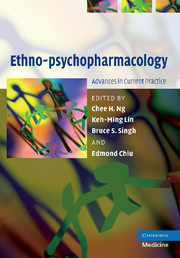Book contents
- Frontmatter
- Contents
- List of figures
- List of tables
- List of contributors
- Foreword
- Acknowledgments
- 1 Introduction
- 2 Culture and psychopathology
- 3 Culture and ethnicity in psychopharmacotherapy
- 4 Ethnic differences in psychotropic drug response and pharmacokinetics
- 5 Pharmacogenetics of ethnic populations
- 6 Variation in psychotropic responses in the Chinese population
- 7 Variation in psychotropic responses in the Hispanic population
- 8 Identifying inter-ethnic variations in psychotropic response in African Americans and other ethnic minorities
- 9 Complementary medicines in mental disorders
- 10 Cultural factors and the use of psychotropic medications
- 11 Outpatient prescribing practices in Asian countries
- 12 Psychiatric inpatient psychotropic prescribing in East Asia
- 13 Pharmaco-economic implications for Asia and other economically disadvantaged countries
- 14 Integrating theory, practice and economics in psychopharmacology
- 15 Research directions in ethno-psychopharmacology
- Index
- References
3 - Culture and ethnicity in psychopharmacotherapy
Published online by Cambridge University Press: 22 August 2009
- Frontmatter
- Contents
- List of figures
- List of tables
- List of contributors
- Foreword
- Acknowledgments
- 1 Introduction
- 2 Culture and psychopathology
- 3 Culture and ethnicity in psychopharmacotherapy
- 4 Ethnic differences in psychotropic drug response and pharmacokinetics
- 5 Pharmacogenetics of ethnic populations
- 6 Variation in psychotropic responses in the Chinese population
- 7 Variation in psychotropic responses in the Hispanic population
- 8 Identifying inter-ethnic variations in psychotropic response in African Americans and other ethnic minorities
- 9 Complementary medicines in mental disorders
- 10 Cultural factors and the use of psychotropic medications
- 11 Outpatient prescribing practices in Asian countries
- 12 Psychiatric inpatient psychotropic prescribing in East Asia
- 13 Pharmaco-economic implications for Asia and other economically disadvantaged countries
- 14 Integrating theory, practice and economics in psychopharmacology
- 15 Research directions in ethno-psychopharmacology
- Index
- References
Summary
Introduction
The use of psychiatric medication has transcended geographic, cultural, and ethnic boundaries during the past several decades (Lin, Poland et al., 1993; Lin & Cheung, 1999; Lin & Smith, 2000). Within a few years of their discovery, modern psychotropics have achieved worldwide acceptance as the mainstay for the treatment of the mentally ill (Lin, Poland et al., 1993; Ng, Lin et al., 2005). This notwithstanding, until most recently, clinicians and researchers have paid little attention to potential influences of ethnic and cultural factors on pharmacotherapeutic responses. With a few prominent exceptions, practically all psychiatric medications have been developed and tested in North America and Western Europe, and often, on “young, white males.” In addition, since these research efforts usually aim at defining what are “typical” that can be generalized, variations in responses are often regarded as “noises” and consequently ignored. Therefore, although substantial differences in psychotropic responses have been repeatedly observed and documented in the literature, such information has not been widely disseminated, and our knowledge in this regard is still sparse and unsystematic. Treatment decisions are generally not individualized; choice of medication and dosing routines are largely based on “trial and error” practices rather than on rational principles.
In contrast, recent literature clearly demonstrates that ethnicity and culture powerfully determine individuals' pharmacological responses (Lin & Poland, 1995). These responses are shaped simultaneously by genetic and environmental factors.
- Type
- Chapter
- Information
- Ethno-psychopharmacologyAdvances in Current Practice, pp. 27 - 37Publisher: Cambridge University PressPrint publication year: 2008
References
- 3
- Cited by



